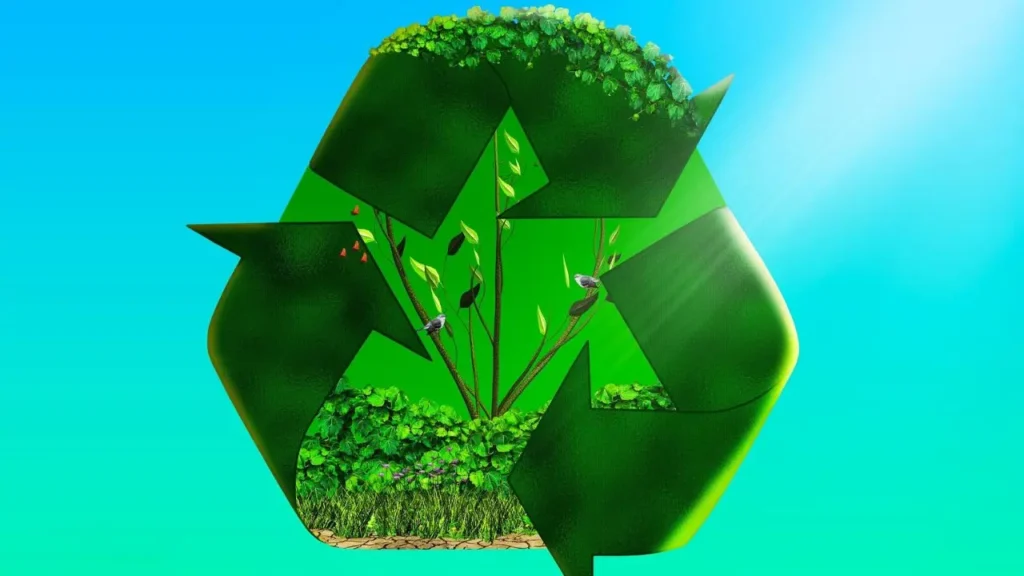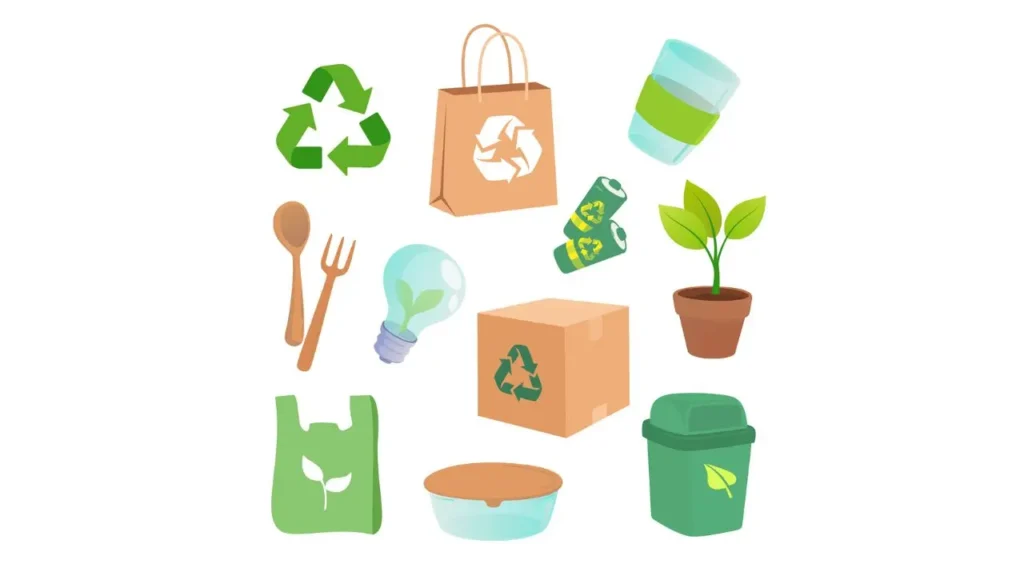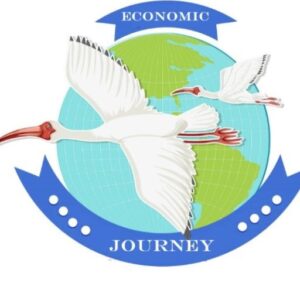
Definition and Principles
The circular economy is an economic concept that is part of sustainable development, the objective of which is to produce goods and services while limiting consumption and waste resources and waste production, through a loop scheme or a virtuous cycle whose incoming and outgoing flows form a closed ecosystem.
It differs from linear production processes in which raw materials are extracted and transformed into products, which are then sold, consumed, and then discarded. This results not only in a scarcity of raw materials, but also in polluting emissions, large quantities of waste, and environmental damage.
It is therefore a question of moving from a disposable society, based on a linear economy, to a circular economic model, which consists of sharing, reusing, repairing, renovating and recycling existing products and materials for as long as possible so that they retain their value, and consequently extending the life cycle of products, breaking with the widespread policy of planned obsolescence.
She is thus compatible with the theories of the economy of frugality or degrowth or happy sobriety and eco-design.
It should be noted that the circular economy, which is one of the pillars of sustainable development, is based on three fundamental principles:
- Preserve and improve natural resources by managing stocks and optimizing their use;
- Optimize product life span through design, repair, reuse and recycling;
- Promote system efficiency by eliminating negative externalities, such as pollution and greenhouse gas emissions.
What are the 7 R of the circular economy ?
The circular economy is based on the so-called “7 R” rule, which are as follows:
- Redesign: consists of thinking and designing products in such a way that their manufacturing process consumes fewer raw materials and generates less waste;
- Refuse to buy what is not a need ;
- Reduce your consumption: by sticking to the necessary quantities through changing our consumption habits. By reducing our consumption, we avoid the production of waste, the use of raw materials, which therefore reduces the impact on the environment ;
- Reuse or repurpose products, favor second-hand purchases and repairs to extend their life cycle ;
- Recycle as a last resort and promote best practices in waste management and use what you can use it as raw material to make new products ;
- Recover : give new uses to products that are going to be discarded ;
- Refurbish : Updating old items so they can be repurposed as vintage.
The pillars of the circular economy
The transition to a circular economy requires progress in several areas, namely :
1- Sustainable procurement
By taking into account the environmental and social impacts of the resources used, especially those associated with their extraction and exploitation and sustainable purchasing.
2- Ecodesign
By taking into consideration the environmental impacts over the entire life cycle of a product and integrating them from its design stage, it aims to minimize the environmental impact of the product life cycle. Moreover, ecodesign is an approach that systematically includes ecological considerations from the earliest stages of product planning, development, and design. It seeks construction methods that ensure minimal consumption of resources and raw materials throughout the product life cycle. The goal is to minimize the environmental impact of the product life cycle.
3- Industrial and territorial ecology
Consists of optimizing resources in a territory through the creation of synergies between several economic actors and the pooling of flows of materials, energy, water, infrastructure and goods and services.
4- The economy of functionality
It is based on the principle of favoring use over possession, through the sale of a service rather than a good.
5- Responsible consumption
It aims to raise awareness and encourage buyers, whether public or private, to take into account environmental and social impacts at all stages of the product life cycle when making their purchasing choices.
6- Extending the duration of use
It consists of extending the lifespan of the product and therefore its use by resorting to repair, sale or second-hand purchase, donation and reuse.
7- The improvement of prevention, of management and waste recycling
This strategy allows us to give a second life to our waste through the reinjection and reuse of materials from waste in the economic cycle.

The benefits of the circular economy
The circular economy is an economic model that brings us many benefits :
1- Protect the environment and biodiversity
Indeed, the use of waste reduction practices, reuse of materials and use of renewable energies, leads to a reduction in the ecological footprint of human activities, which allows to :
- Slow down the use of natural resources ;
- Ensure efficient and sustainable materials management ;
- Reduce landscape and habitat disturbance ;
- Limit the loss of biodiversity ;
- Reduce the exploitation of limited resources ;
- Reduce the amount of waste ;
- Optimize energy and resource consumption ;
- Reduce greenhouse gas emissions and water and soil pollution.
2- Reduce dependence on raw materials
Recycling products allows us to :
- Mitigate risks associated with procurement ;
- Protect against price volatility ;
- Moving away from the availability issue ;
- Increase security of resource supply ;
- Limit dependence on imports ;
- Preserve natural resources ;
- Mitigate tensions related to intensive resource extraction.
3- Create jobs
The move towards a circular economy could :
- Increase competitiveness;
- Stimulate innovation ;
- Improve profitability ;
- Stimulate economic growth ;
- Stimulate innovation in different sectors of the economy ;
- Create new activities, particularly in the sectors of eco-design, natural resource management and renewable energies.
- Create business opportunities in emerging sectors, such as waste management, product repair and sustainable materials design.
4- Save money for the consumer
- Benefit from more sustainable and innovative products ;
- Improve their quality of life ;
- Respond to new consumption patterns ;
- Access to cheap products.
5- Strengthening social cohesion
- Thanks to the sharing and repair models.
The challenges of the transition to a circular economy
The transition to a circular economy is not a simple goal. Several challenges are being thwarted, its implementation including:
- Limited knowledge. Not all countries are aware of the potential of the circular economy or have a strategy to implement it ;
- Businesses, particularly small and Medium-Sized Enterprises (SME), often struggle to access adequate financing to enable them to move from linear to circular models ;
- The transition to circular practices can take a long time ;
- The transition requires not only adequate investment and financing, but also knowledge transfer, community strengthening and training throughout its development ;
- Businesses do not always have access to sufficient subsidies or financial support to offset the additional costs associated with the transition to the circular economy ;
- The difficulty of changing consumer behavior to encourage them to adopt more sustainable consumption habits ;
- This ecological transition also requires significant communication and awareness campaigns.
Conclusion
The circular economy has several objectives to promote the ecological transition by going beyond the linear economic model of extracting, manufacturing, consuming and throwing away, to adopt a new model of economic circularity based on the sober and responsible consumption of natural resources and primary raw materials to address the challenges of over consumption and waste in order to develop a more sustainable and resilient society, capable of adapting to environmental challenges and meeting the needs of future generations.

Наткнулся на полезную статью, думаю, вам тоже пригодится:
Кстати, если вас интересует qazar.ru, загляните сюда.
Вот, можете почитать:
https://qazar.ru
Всем спасибо, и до новых встреч!
Мамочки, делимся новостями на Mamas.Ru. Какие темы вас особенно заинтересовали в марте?
Между прочим, если вас интересует Популярные рецепты и кулинарные советы, загляните сюда.
Вот, делюсь ссылкой:
http://mamas.ru/recepty.php
Это были самые горячие обсуждения марта. Ждем вас с новыми темами в следующем месяце.
Чтобы было понятнее, о чем речь:
Зацепил материал про musichunt.pro.
Вот, делюсь ссылкой:
https://musichunt.pro
Если у вас есть что добавить, не стесняйтесь.
Недавно столкнулся с похожей ситуацией, и вот что помогло:
Хочу выделить материал про diyworks.ru.
Смотрите сами:
https://diyworks.ru
Буду следить за обсуждением.
Если кому интересно, вот более детальная информация:
Особенно понравился раздел про diyworks.ru.
Вот, делюсь ссылкой:
https://diyworks.ru
Всем мира и продуктивного дня
Возможно, это будет полезно участникам обсуждения:
Хочу выделить раздел про yogapulse.ru.
Смотрите сами:
https://yogapulse.ru
Если у вас есть что добавить, не стесняйтесь.
Вот здесь можно найти больше примеров:
Для тех, кто ищет информацию по теме “idalgogrif.ru”, есть отличная статья.
Вот, можете почитать:
https://idalgogrif.ru
Может, у кого-то есть другой опыт?
Вот отличный материал, который проливает свет на ситуацию:
Особенно понравился раздел про buytime.ru.
Вот, можете почитать:
https://buytime.ru
Спасибо за внимание.
Вот здесь подробно расписано, как это сделать:
Между прочим, если вас интересует mersobratva.ru, посмотрите сюда.
Вот, можете почитать:
https://mersobratva.ru
Чем мог, тем помог.
Вас интересуют природные богатства России? Давайте исследуем их вместе!
Между прочим, если вас интересует Изучение ООПТ России: парки, заповедники, водоемы, посмотрите сюда.
Вот, можете почитать:
https://alloopt.ru
Жду ваших отзывов и вопросов по теме.
Откройте для себя прекрасные и загадочные места, которые находятся под охраной в нашей стране.
Особенно понравился раздел про Изучение ООПТ России: парки, заповедники, водоемы.
Вот, делюсь ссылкой:
https://alloopt.ru
Спасибо за внимание! Надеюсь, вам было интересно.
**mind vault**
mind vault is a premium cognitive support formula created for adults 45+. It’s thoughtfully designed to help maintain clear thinking
Добро пожаловать в удивительный мир природы России!
Кстати, если вас интересует Изучение ООПТ России: парки, заповедники, водоемы, посмотрите сюда.
Смотрите сами:
https://alloopt.ru
Жду ваших отзывов и вопросов по теме.
Хотите узнать больше о природе нашей страны? Присоединяйтесь к обсуждению.
По теме “Изучение ООПТ России: парки, заповедники, водоемы”, есть отличная статья.
Ссылка ниже:
https://alloopt.ru
Надеюсь, вы нашли это путешествие по природе познавательным.
Откройте для себя прекрасные и загадочные места, которые находятся под охраной в нашей стране.
Кстати, если вас интересует Изучение ООПТ России: парки, заповедники, водоемы, загляните сюда.
Смотрите сами:
https://alloopt.ru
Спасибо за внимание! Надеюсь, вам было интересно.
90’lar modas?n?n guzellik s?rlar?yla gunumuzun trendlerine meydan okumaya ne dersiniz?
Для тех, кто ищет информацию по теме “Evinizde Estetik ve Fonksiyonu Birlestirin: Ipuclar? ve Trendler”, там просто кладезь информации.
Вот, можете почитать:
https://anadolustil.com
90’lar?n guzellik s?rlar?yla tarz?n?za yeni bir soluk kazand?rabilirsiniz. Eski moda, yeni size ilham olsun!
What’s up mates, nice piece of writing and pleasant urging commented at this place, I am genuinely enjoying by these.
https://join.com.ua/yak-ne-pomylytys-pry-pokuptsi-bi-led-linz-cherez-i.html
Guzellik ve kozmetikte her zaman gecmisten al?nacak dersler bulunur. 90’lar?n modas?ndan guzellik s?rlar?n? kesfetmeye haz?r olun.
Особенно понравился раздел про Guzellik ve Kozmetik: Trendler ve Ipuclar?.
Смотрите сами:
https://guzellikturk.com
90’lar modas?n?n guzellik s?rlar?n? kesfetmek, tarz?n?za farkl? bir boyut kazand?rabilir. Denemeye deger degil mi?